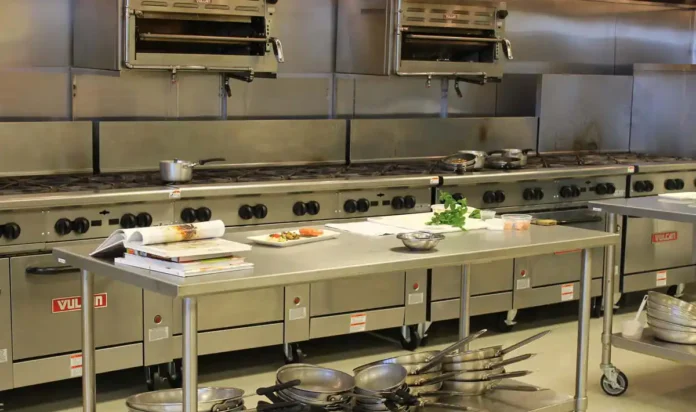
When you first started your food business, you may have begun creating products in your home kitchen. Indeed, you may still be producing food items at home or in a small commercial kitchen.
But as your business becomes more and more successful, you will need to look at how to scale up your kitchen production. Here are six ways to do precisely that.
1. Move to Bigger Premises
When you are ready to significantly increase your kitchen’s production of food products, you will need to find a bigger kitchen.
You can either rent or buy premises that come with a large kitchen or move into an empty space that you fit out with existing and new kitchen equipment.
Whichever option you choose, make sure you spend time carefully working out costs. After all, moving into a new kitchen needs to make sound financial sense.
Furthermore, when scaling up your production, you will need more employees, so ensure you factor in those additional costs as well.
2. Adjust Your Formulas for Scaling up Your Food Production
When making recipes for more people at home, you can simply double or triple your recipe using the same ingredients. But when you scale up your production for commercial food products, things are not that simple.
For instance, when producing large quantities of your foods, ingredients may not behave in the same way, so you would need to adjust your ingredients and the quantities of your ingredients in order to achieve the same tasty recipe when you are producing large quantities of your food products.
You may also need to swap one ingredient for another if you find the ingredients you currently use are too expensive when you need to buy them in bulk in order to meet your price target.
Furthermore, the stability of ingredients may not meet the needs of your new process and the finished product could have a different taste or texture, so you will need to spend some time experimenting to ensure you can reproduce your recipes, without compromising on quality, at a large scale.
3. Consider Changing Your Sourcing Strategy
Do not assume that your sourcing strategy will remain the same when scaling up your kitchen’s production. Sourcing larger quantities of ingredients can impact your business in multiple ways.
For instance, you could need to rewrite formulas in order to hit your price point and, if you use specialty ingredients, you could find it difficult to source them in the new larger quantities that you require.
You may need to find a new supplier, and that could further affect your costs.
While ingredient costs generally do not have a significant impact on profit margins at a small scale, they will impact your profit margins much more once you start scaling up.
So, make sure you look at the ingredients you need and do plenty of calculations before you proceed in scaling up so that you can identify whether you need to change your sourcing strategy.
4. Invest in Larger Industrial Machinery
When producing food products at a larger scale, you will need to invest in larger, industrial machinery. For example, you will probably need industrial mixer machines.
Mixing is a complex process, so you will need to spend some time looking at what your requirements are so that you can select the right mixers and other machines.
After all, mixing fifty gallons of ingredients will be a very different process from mixing ingredients in a 2,000-gallon tank.
There are multiple types and sizes of mixers available and you will need to use your expert knowledge to select the right ones for your purposes. For instance, you could need static, high-shear, or helical mixers.
Choosing the wrong mixers or other food production machinery can be costly, both in terms of expense and quality, so make sure you look at your specific requirements before you proceed with buying items like mixers.
5. Consider Your Production Requirements and Future Needs
When considering your production needs so that you can do things like purchase the appropriate equipment, you also need to consider your future needs. You should have a plan for business growth in place. With your plan in hand, you can better determine your current and future production requirements.
For instance, you could be planning on producing limited seasonal food products, in which case you will need to factor in the equipment you will need and the costs of producing new lines.
Alternatively, you may be planning to deliver your food, in which case you could need to find a reliable on demand delivery service.
6. Pay Attention to Yield Loss
When scaling up your kitchen’s production, you need to pay even more attention to potential yield loss than you already do. After all, when you use large quantities of ingredients, it is more likely that you will have a higher amount of product loss if you do not put practices in place to prevent it.
For instance, getting a thick food product out of a large vessel will require new mechanical aids if you do not want to lose a significant proportion of the product when transferring it from the large vessel.
You may need to employ scrape agitation, vacuum, or pressure methods to ensure all of the product is attained during transference.
You could also look at repurposing waste food products. For instance, leftover cheese during the production of a food product could be repurposed as a food product itself.
Final Thoughts
Scaling up your kitchen’s production in the right way, so that you can maximize production at a cost-effective and profitable level, ultimately comes down to good planning.
You should spend a lot of time looking at the things you need to do to scale up and then work out the costs for each factor in order to make your growth successful.
So, to recap, you should:
- Move to Bigger Premises.
- Adjust Your Formulas for Scaling up Your Food Production.
- Consider Changing Your Sourcing Strategy.
- Invest in Larger Industrial Machinery.
- Consider Your Production Requirements and Future Needs.
- Pay Attention to Yield Loss.

























